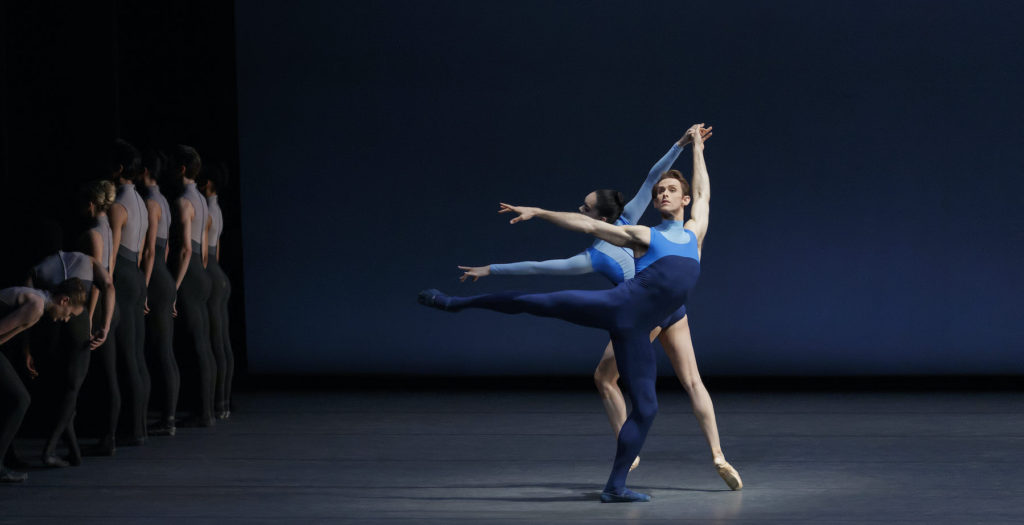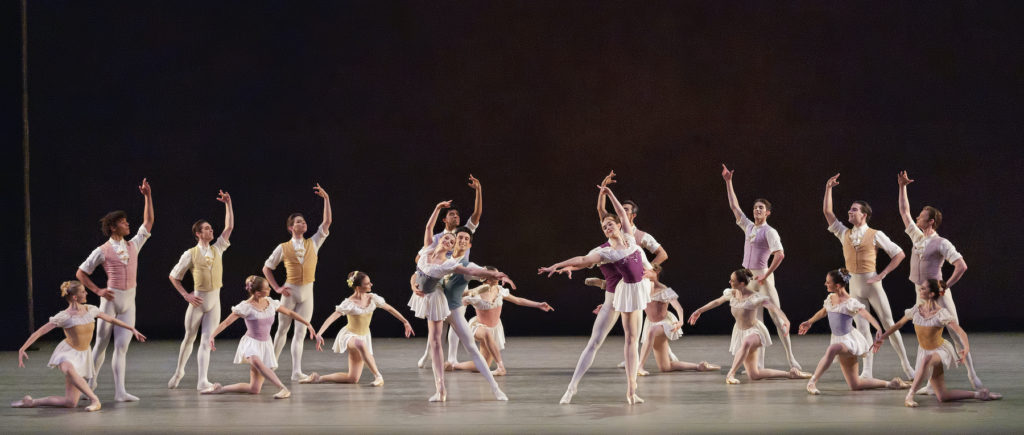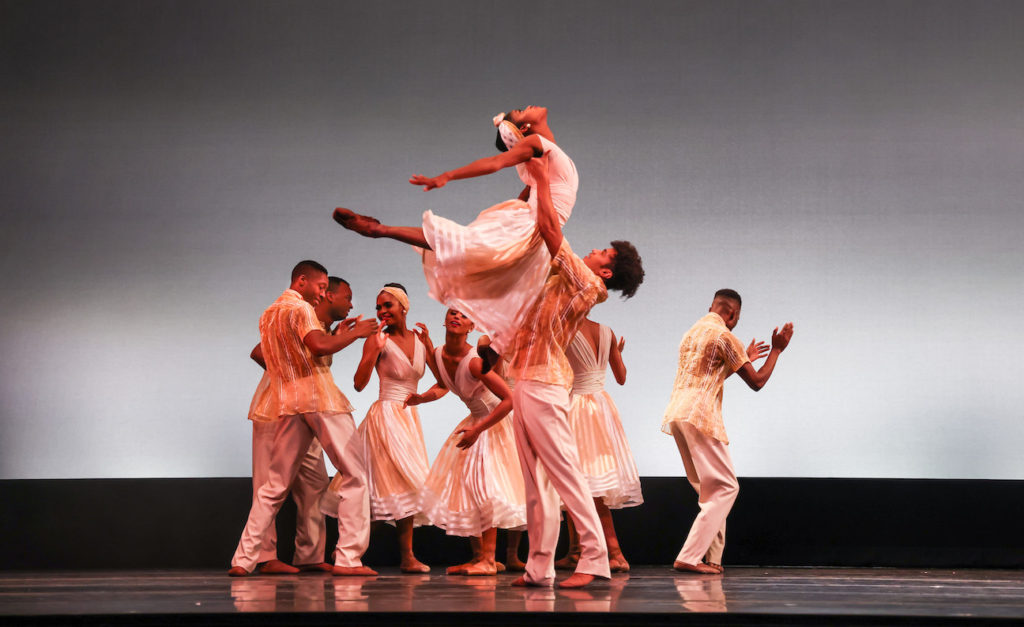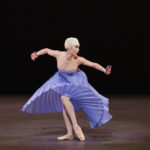New York: A bright burst of spring from three major players - Vancouver Ballet Society
- Home
- City Reports 2020 - 2023
- New York: A bright burst of spring from three major players

By Robert Greskovic
By mid-April, with the COVID pandemic seemingly in the rear-view mirror and the Passover and Easter holidays over, New York City’s dance calendar felt like a burgeoning rite of spring. In one week, New York City Ballet, the Martha Graham Dance Company, and Dance Theatre of Harlem competed nightly for audiences.
The Graham company’s two-week season opened at the Joyce Theater on April 18, a date coinciding with the group’s 97th birthday. In its first extended run at home in New York since the start of the pandemic, the company’s two newest entries to its repertoire, each with a group dynamic focus, were slight. Get Up, My Daughter by Annie Rigney, a New York-based choreographer and Gaga teacher, was set to a blend of Bulgarian folk music and original compositions by Marco Rosano. Cortege 2023, co-created by Amadi “Baye” Washington and Sam “Asa” Pratt (to Aidan Elias’ score with echoes of Eugene Lester’s music for Graham’s 1967 Cortege of Eagles), was seemingly more of a first draft than a finished piece.
Besides reliable performances of Graham classics Cave of the Heart (1946) and Embattled Garden (1958), the season gave its company’s namesake all due honour with a stirring performance of her onrushing Panorama (1935). The performance of this 11-minute modernist work was a project with NYC Department of Education teens, among whom high-schooler Genesis Lindo stood out in a cast of 23 for her vibrant fervour.

New York City Ballet launched its six-week run at Lincoln Center (which continued into late May) directly opposite the Graham company’s opening, with new works that similarly paled against its tried and true dances. Christopher Wheeldon’s From You Within Me, to Arnold Schoenberg’s Verklärte Nacht, held the stage more atmospherically than memorably. Its dedicated cast of 12 seemed lost — despite some passing choreographic focus on Sara Mearns — amid its specially commissioned brush-stroke designs from painter Callie Manning. On the same evening, Alysa Pires (a former choreographic associate at the National Ballet of Canada) presented Standard Division, a 15-dancer work to a commissioned score by Australian Jack Frerer. This proved game-like for its 12-strong ensemble, revealing prominent work for their bare arms, while the pronounced legwork for featured dancers Tiler Peck and Mira Nadon, who was paired with Adrian Danchig-Waring, faded in impact amid the geometric configurations and rearrangements for the ensemble.

Works by both NYCB founding choreographers George Balanchine and Jerome Robbins potently graced the season with their typically expert choreographic inventions. Giving the season happy high points were lustrous performances of Balanchine’s La Source (1969, to Delibes), led with requisite confidence and ease by Indiana Woodward and Joseph Gordon, and daring ones of his athletic Kammermusik No. 2 (1978, to Hindemith), showcasing Nadon with Aaron Sanz and Emilie Gerrity with Peter Walker.
A loving re-staging in early May, for the first time in 15 years, of Robbins’ Brandenberg (1997, to J. S. Bach) brought much distinction to the season. It was as youthfully playful as The Goldberg Variations (1971) — another of Robbins’ winning showcases to Bach — is grand and momentous. Brandenberg provides today’s NYCB dancers with fresh impetus to embody the point and counterpoint accents of Bach’s music-making. The current cast’s two featured couples led with precision and fleetness artfully framed by an ensemble of eight couples.

Another standout, marvellously paired with La Source, was Namouna, A Grand Divertissement (2010, to Éduoard Lalo) by Alexei Ratmansky (who will become NYCB artist in residence in the fall), which filled the stage with dancing of wit, grandeur, and virtuosity. (Roman Mejia’s Instagram account Roman.Julian.Mejia has excerpts of his performance of the sailor in Namouna.) Finally, NYCB resident choreographer and artistic advisor Justin Peck also buoyed the programming with presentations of his The Times Are Racing (2017, to recorded music of Dan Deacon), in which an animated and often racing sneaker-shod ensemble pours forth individuals to claim attention among the urgent throng.
Because of the congestion that marked the crowded week in April, I caught only one performance of Dance Theatre of Harlem at New York City Center. Its five-day run celebrated Virginia Johnson, the company’s retiring artistic director, who assumed the reins on the death of founder Arthur Mitchell. She will be succeeded in July by Robert Garland.

The program I saw opened with a vivid performance of Balanchine’s Allegro Brillante (1956, to Tchaikovsky), led with brio and unaffected energy by Ingrid Silva and Christopher McDaniel. Sounds of Hazel (2022, a local premiere) was an homage to jazz pianist and singer Hazel Scott, a woman the program describes as “inimitable yet virtually unknown,” and who was introduced in a short documentary film. The approximately 20-minute suite of music, dance, and sound-bite scenes has choreography by NYC-based choreographer and concert dance curator Tiffany Rea-Fisher and music direction by Erica “Twelve45” Blunt. The result is light as dance theatre and of interest primarily in helping put Scott and her life before us.
The Dance Theatre of Harlem bill closed with the company’s New York premiere of Blake Works IV (The Barre Project) by William Forsythe (2020, to recorded songs written and performed by James Blake). A simple conceit has its cast of 14 dancers take various places at a barre, where they get to distinguish themselves and their individually expressive ballet schooling by flashing and otherwise articulating their limbs and torsos. Sleekly dressed in Forsythe and Katy A. Freeman’s panne velvet costuming, the dancers glowed under Brandon Stirling Baker’s artful lighting.

